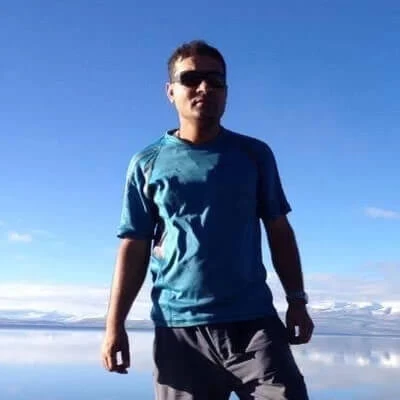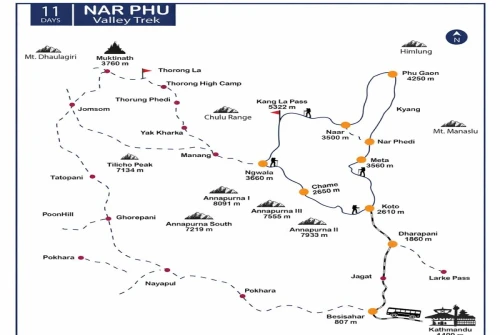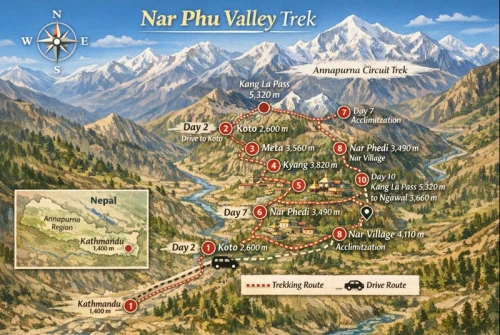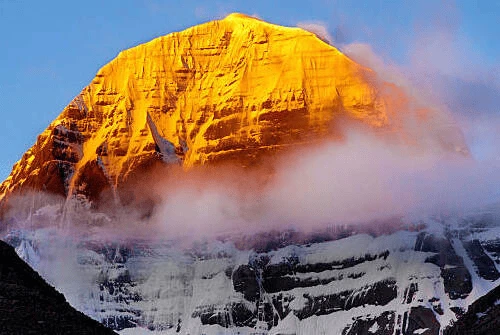
Island Peak, also known as Imja Tse, is a prominent mountain in the Himalayas of Nepal. This iconic peak stands at an elevation of 6,189 meters (20,305 feet) above sea level and is a popular destination for mountaineers and trekkers. It is situated within the Sagarmatha National Park, a UNESCO World Heritage Site, and offers breathtaking views of some of the world's highest peaks, including Mount Everest. Island Peak's distinctive pyramid shape and challenging ascent make it a sought-after objective for climbers seeking both adventure and stunning vistas in the heart of the Himalayas.
Location: Island Peak, also known as Imja Tse, is located in the Khumbu region of Nepal, which is home to the world's highest peak, Mount Everest. It's situated within the Sagarmatha National Park, a UNESCO World Heritage Site.
Altitude: Island Peak stands at an impressive elevation of 6,189 meters (20,305 feet) above sea level. This high altitude makes it an attractive goal for those looking to experience high-altitude mountaineering without tackling the full ascent of Everest.
Difficulty: While Island Peak is categorized as a trekking peak, it's more than just a hike. Climbers are required to have a good level of physical fitness and some basic mountaineering skills. These skills include using climbing gear like ropes, crampons, and ice axes and knowing glacier travel techniques.
Climbing Season: The optimal times to attempt the ascent of Island Peak are during the pre-monsoon (spring) season, which typically runs from April to May, and the post-monsoon (autumn) season, which spans from September to November. These periods offer the most stable weather and favorable climbing conditions.
Permits: When planning your Island Peak expedition, you'll need to obtain several permits. These include a TIMS (Trekkers' Information Management System) card, a Sagarmatha National Park entry permit, and a specific climbing permit for Island Peak. These permits are essential to ensure the protection of the region and can usually be organized through local trekking agencies or the Nepal Tourism Board.
Itinerary: Most climbers and trekkers incorporate Island Peak into a more extensive trekking route, such as the famous Everest Base Camp trek. The journey usually begins in Lukla and takes you through the breathtaking Khumbu region, with a stop at Chukhung before reaching the Island Peak Base Camp.
Accommodation: Accommodation options during the trek to Island Peak can vary. Along the trekking route, you'll find teahouses or lodges where you can rest and have meals. However, when you reach the Island Peak Base Camp, you'll need camping equipment, as you'll be camping there.
Guided Expeditions: Many climbers opt for guided expeditions to Island Peak. These expeditions provide essential logistics, equipment, and experienced guides who are well-versed in the route and can offer vital support and instruction, ensuring a safer and more successful climb.
Summit Day: The summit day is the culmination of your journey. It usually starts very early in the morning, around 2 or 3 a.m., to take advantage of the stable weather conditions. The ascent involves climbing a steep snow and ice slope before reaching the summit, which provides breathtaking panoramic views of the surrounding Himalayan peaks, including the iconic Mount Everest.
Safety and Acclimatization: Adequate acclimatization is of utmost importance when climbing Island Peak, as altitude-related illnesses are a serious concern. Proper training and acclimatization days built into the trek are essential to ensure a safe and successful climb. It's important to listen to your body and allow it time to adjust to the thin air at high altitudes.
Island Peak offers a unique and rewarding experience, allowing trekkers and mountaineers to combine a challenging trek with a taste of high-altitude mountaineering while enjoying some of the world's most stunning mountain vistas. Planning and preparation are key to a safe and memorable adventure in this breathtaking region.

Mera Peak, a majestic mountain in the Khumbu region of Nepal, is one of the highest trekking peaks in the world, soaring to an impressive height of 6,476 meters (21,247 feet) above sea level. Located within the Sagarmatha National Park, which is home to the iconic Mount Everest, Mera Peak has become a coveted destination for both seasoned mountaineers and trekkers seeking a challenging yet rewarding adventure. With its distinctive summit, Mera Peak offers panoramic views of some of the most awe-inspiring Himalayan peaks, including the world's highest, Mount Everest. As a non-technical climb, Mera Peak attracts adventurers from around the globe who are eager to test their mountaineering skills and experience the enchanting beauty of the Everest region. Here's an overview of Mera Peak:
Location: Mera Peak is located in the Solu-Khumbu district of Nepal, in the Hinku Valley. It is part of the Sagarmatha National Park, which is home to the world-famous Everest region.
Trekking and Climbing: Mera Peak is primarily known for trekking and mountaineering. The trek to Mera Peak involves passing through beautiful forests, crossing high-altitude passes, and experiencing the unique culture and traditions of the Sherpa people. The climb to the summit of Mera Peak is not technically challenging, making it an ideal option for beginner mountaineers.
Acclimatization: Proper acclimatization is essential when climbing Mera Peak, as it reaches a significant altitude. Trekkers typically spend several days at various high-altitude camps to acclimatize before attempting the summit.
Views: Mera Peak offers stunning panoramic views of several of the world's highest mountains, including Mount Everest (8,848 meters), Lhotse (8,516 meters), Makalu (8,485 meters), and Kanchenjunga (8,586 meters). The views from the summit are breathtaking and make the climb worthwhile.
Difficulty: While Mera Peak is considered a non-technical climb, it is still a physically demanding endeavor due to the altitude and the rigors of high-altitude trekking. Climbers need to be in good physical condition and have some prior trekking or mountaineering experience.
Best Time to Visit: The best time to visit Mera Peak is during the pre-monsoon (spring) season, from March to May, and the post-monsoon (autumn) season, from September to November. These months offer stable weather and clear skies for the climb.
Permits: You will need a climbing permit and a TIMS (Trekkers' Information Management System) card to trek to Mera Peak. It is advisable to obtain these permits through a reputable trekking agency.
Guides and Porters: Many trekkers and climbers hire local guides and porters to assist with logistics, navigation, and carrying equipment. This not only supports the local economy but also enhances the safety and overall experience of the trek.
Accommodation: Accommodation options during the trek vary from basic teahouses in lower altitudes to camping at higher altitudes. Teahouses provide simple meals and lodging, while higher up, you may need to bring your own camping gear.
Safety: Safety is a top priority when climbing Mera Peak. Proper gear, experienced guides, and adherence to recommended acclimatization schedules are crucial to a successful and safe ascent.
Mera Peak offers an excellent introduction to high-altitude trekking and mountaineering in the Himalayas and provides an opportunity to experience the stunning natural beauty and rich culture of the Khumbu region in Nepal.

Lobuche Peak, nestled in the stunning Khumbu region of Nepal, is a prominent and alluring mountain that captures the imagination of climbers and trekkers alike. With a soaring elevation of 6,119 meters (20,075 feet) above sea level, Lobuche Peak is a popular choice for those seeking a thrilling high-altitude experience in the vicinity of Mount Everest. Situated within the Sagarmatha National Park, this challenging peak offers spectacular vistas of the surrounding Himalayan giants, including the iconic Mount Everest. While Lobuche Peak is technically demanding, it remains an attractive prospect for adventurers looking to test their mountaineering skills and immerse themselves in the awe-inspiring landscapes of the Everest region. Here's an overview of Lobuche Peak:
Location: Lobuche Peak is situated in the Khumbu region of Nepal, in the Sagarmatha National Park. It lies between the Khumbu and Imja Valleys and is near the iconic Mount Everest.
Trekking and Climbing: Lobuche Peak offers a more technical climbing experience compared to some other trekking peaks in the region. It has two main summits: Lobuche East (6,119 meters) and Lobuche West (6,145 meters). Lobuche East is the more commonly climbed peak and is considered a challenging trekking peak. Climbing Lobuche West involves more advanced technical skills.
Difficulty: Climbing Lobuche Peak, particularly Lobuche East, requires a good level of physical fitness and previous high-altitude trekking or mountaineering experience. The ascent to the summit can be physically demanding, and technical skills, such as the use of ice axes and crampons, are necessary.
Views: The summit of Lobuche Peak offers stunning panoramic views of the Everest, Lhotse, Nuptse, Ama Dablam, and other Himalayan peaks. The vistas from this peak are breathtaking and make the climb rewarding.
Best Time to Visit: Like many other peaks in the Khumbu region, the best times to attempt Lobuche Peak are during the pre-monsoon (spring) season, from March to May, and the post-monsoon (autumn) season, from September to November. These months provide the best weather conditions and visibility for climbing.
Permits: Climbers need to obtain a climbing permit for Lobuche Peak. It is advisable to do this through a reputable trekking agency to ensure all necessary documentation and logistics are taken care of.
Guides and Porters: Hiring experienced local guides and porters is recommended for the climb. They can assist with route finding, safety, and logistics, making the climb more manageable.
Accommodation: Accommodation options on the way to Lobuche Peak include teahouses and camping, similar to the Mera Peak trek. Teahouses provide basic lodging and meals in lower-altitude villages, while camping may be necessary at higher altitudes.
Safety: Safety is a significant concern when climbing Lobuche Peak, particularly due to its technical nature. Climbers must be well-prepared with the right equipment, clothing, and training. Proper acclimatization and taking the necessary time to adapt to the altitude are vital.
Lobuche Peak offers a more challenging and technical climbing experience for those looking to push their mountaineering skills in the beautiful Khumbu region. The combination of stunning mountain scenery and the sense of accomplishment in reaching the summit makes it a popular choice among adventurous climbers and trekkers.

Pisang Peak, a magnificent mountain in the Annapurna region of Nepal, is a notable attraction for climbers and trekkers who are drawn to its challenging ascent and breathtaking views. Rising to an elevation of 6,091 meters (19,983 feet) above sea level, Pisang Peak stands as one of the popular "trekking peaks" in the Himalayas. It is situated in close proximity to the picturesque village of Pisang, and its distinct summit offers panoramic vistas of the Annapurna and Manaslu mountain ranges. The climb to Pisang Peak, while technically demanding, provides an incredible opportunity for adventurers to test their mountaineering skills while immersing themselves in the natural beauty and cultural richness of the Annapurna region. This peak is a sought-after destination for those seeking a perfect blend of adventure and Himalayan splendor. Here's an overview of Pisang Peak:
Location: Pisang Peak is located in the Annapurna region of Nepal, specifically in the Manang district. It is situated in the northern part of the Annapurna Conservation Area, near the popular Annapurna Circuit trek.
Trekking and Climbing: Pisang Peak is a popular choice for both trekking and mountaineering. Trekkers can incorporate the peak into their Annapurna Circuit trek, while climbers can take on the challenge of ascending the peak. The ascent is not overly technical, making it accessible to climbers with basic mountaineering skills.
Difficulty: While Pisang Peak is considered one of the more straightforward trekking peaks in Nepal, it still requires a reasonable level of physical fitness and the ability to acclimatize to higher altitudes. Climbers should have some experience with ice and snow travel, as well as basic mountaineering techniques.
Views: The summit of Pisang Peak offers breathtaking panoramic views of the surrounding Annapurna and Manaslu mountain ranges, including Annapurna II, Annapurna III, Annapurna IV, Gangapurna, Tilicho Peak, and many more.
Best Time to Visit: The best times to attempt Pisang Peak are during the pre-monsoon (spring) season, from March to May, and the post-monsoon (autumn) season, from September to November. These months typically provide the best weather conditions and visibility for climbing.
Permits: Climbers need to obtain the necessary permits to ascend Pisang Peak. These permits are often arranged through a trekking agency, which can help with the paperwork and logistics.
Guides and Porters: While it's not mandatory, it is advisable to hire local guides and porters to assist with navigation, safety, and logistics. Experienced guides can help you navigate the route and make the climb more enjoyable.
Accommodation: Accommodation options during the trek to Pisang Peak include teahouses and camping. Teahouses provide basic lodging and meals in lower-altitude villages, while camping is typically required at higher altitudes.
Safety: Safety is always a concern when climbing any peak. Proper equipment, clothing, and acclimatization are crucial for a safe ascent. Hiring a guide with local knowledge can also enhance safety.
Pisang Peak is an excellent option for individuals looking to experience Himalayan mountaineering without tackling the technical challenges of more advanced peaks. Its proximity to the Annapurna Circuit and the stunning mountain vistas make it a popular choice for trekkers and climbers alike.

Yala Peak, situated in the Langtang region of Nepal, is a captivating mountain that beckons to climbers and trekkers with its accessible yet exhilarating ascent and stunning vistas. This picturesque peak rises to an elevation of 5,520 meters (18,110 feet) above sea level, making it an attractive option for those looking to experience high-altitude mountaineering without the extreme technical challenges of some of its higher counterparts. Located in the Langtang National Park, Yala Peak provides breathtaking panoramic views of the Langtang range, including Langtang Lirung and Dorje Lakpa. With a less demanding technical aspect, Yala Peak offers a remarkable opportunity for adventurers to hone their mountaineering skills while immersing themselves in the natural beauty and cultural charm of the Langtang region. It's a favored destination for those seeking a blend of adventure and Himalayan allure. Here's an overview of Yala Peak:
Location: Yala Peak is situated in the Langtang region of Nepal, to the north of Kathmandu. It is part of the Langtang National Park, which is known for its beautiful alpine scenery and rich biodiversity.
Trekking and Climbing: Yala Peak is primarily known for trekking and mountaineering. The trek to Yala Peak takes you through stunning landscapes, including lush forests, rhododendron-covered hills, and serene high-altitude lakes. The climb to the summit of Yala Peak is generally considered non-technical and feasible for individuals with limited mountaineering experience.
Difficulty: Yala Peak is one of the more straightforward trekking peaks in Nepal. While some basic mountaineering skills are necessary, the ascent does not require advanced technical knowledge. Climbers should be in good physical condition and capable of acclimatizing to higher altitudes.
Views: The summit of Yala Peak offers impressive panoramic views of the surrounding Langtang and Ganesh Himal ranges. On a clear day, you can see peaks such as Langtang Lirung (7,234 meters), Dorje Lakpa (6,966 meters), and Gangchempo (6,387 meters).
Best Time to Visit: The best times to attempt Yala Peak are during the pre-monsoon (spring) season, from March to May, and the post-monsoon (autumn) season, from September to November. These months typically provide stable weather conditions and clear skies.
Permits: Climbers need to obtain the necessary permits to ascend Yala Peak. These permits are usually facilitated through a trekking agency, which can assist with the necessary documentation and logistical arrangements.
Guides and Porters: Hiring local guides and porters is advisable for your safety and convenience. Experienced guides can provide guidance on the route and ensure a smoother and safer climb.
Accommodation: Accommodation options during the trek to Yala Peak include teahouses and camping. In lower-altitude villages, teahouses offer basic lodging and meals. At higher elevations, camping may be necessary.
Safety: Safety is paramount when climbing Yala Peak. Proper equipment, clothing, and acclimatization are essential for a safe ascent. Hiring local guides with knowledge of the terrain and conditions can enhance safety.
Yala Peak is a fantastic choice for individuals looking to experience Himalayan trekking and mountaineering without the technical challenges of more advanced peaks. Its proximity to Kathmandu, stunning natural beauty, and relatively lower altitude make it accessible and popular among trekkers and mountaineers alike.
Key Highlights Of Island Peak, Lobuche Peak, Pisang Peak, Yala Peak and Mera Peak.
Here's a summary of key considerations for each peak to help you make an informed decision:
Island Peak:
Offers iconic views of Everest and surrounding peaks.
Requires intermediate mountaineering skills.
Located in the Everest region.
Longer trek along the Everest Base Camp route.
Suitable for those seeking a challenging but achievable climb.
Lobuche Peak:
Provides stunning views of Everest and the Everest region.
Requires intermediate to advanced mountaineering skills.
Also located in the Everest region.
Longer trek along the Everest Base Camp route.
Ideal for experienced climbers looking for a technical challenge.
Pisang Peak:
Offers diverse landscapes in the Annapurna region.
Suitable for novice climbers with basic mountaineering skills.
Closer to Kathmandu, making it accessible for those with limited time.
A more cost-effective option.
Recommended for those looking for a beautiful trek and a moderately challenging climb.
Yala Peak:
Features serene alpine landscapes in the Langtang region.
Suitable for beginners with limited mountaineering experience.
Highly accessible from Kathmandu.
Ideal for individuals seeking a less technical and shorter expedition.
A great choice for those new to high-altitude trekking and climbing.
Mera Peak:
Offers breathtaking views of Everest and nearby peaks.
Requires advanced mountaineering skills and excellent altitude tolerance.
Located in a remote region, requiring a more extended trek.
Involves a higher level of physical and technical challenge.
Suited for experienced climbers looking for a significant mountaineering adventure.
How to Choose Between Top 5 Peaks: Island Peak, Lobuche Peak, Pisang Peak, Yala Peak, and Mera Peak?
Choosing between Island Peak, Lobuche Peak, Pisang Peak, Yala Peak, and Mera Peak depends on your experience, fitness level, and personal preferences. Each of these peaks offers a unique mountaineering experience. Here are some factors to consider when making your choice:
Ultimately, your choice should align with your experience, comfort level with altitude, and the type of experience you seek. It's essential to thoroughly research and prepare for your chosen peak, and you may consider consulting with a reputable trekking agency to help plan your expedition.
Conclusion
When choosing between Island Peak, Lobuche Peak, Pisang Peak, Yala Peak, and Mera Peak, the decision should revolve around your individual mountaineering experience, physical fitness, and the type of Himalayan adventure you seek. If you're a novice climber or prefer a less technical climb, Yala Peak and Pisang Peak are excellent options, offering accessible treks and moderate challenges. For those with intermediate to advanced mountaineering skills and a desire for iconic views, Island Peak and Lobuche Peak in the Everest region present exciting challenges. Mera Peak, situated in a remote region, beckons experienced mountaineers seeking a physically and technically demanding ascent. While all these peaks offer the allure of the Himalayas, your choice should align with your aspirations and preparedness, and consulting with a reputable trekking agency is recommended to plan a successful and safe expedition.









